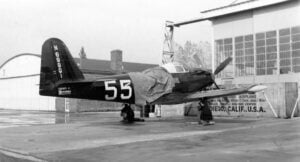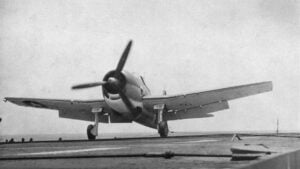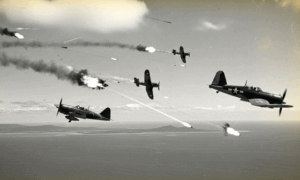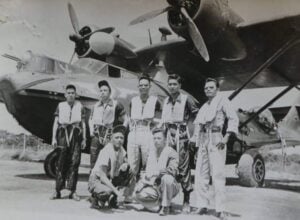5 Rare WWII Aircraft Restorations We Can View Today

Planes of Fame / YouTube
Throughout the course of World War II, aircraft played a crucial role in the machinery of war, marking an era of rapid technological development. Some of these iconic machines have now been painstakingly restored, offering us a glimpse into the past. Here, we explore five notable WWII aircraft restorations that enthusiasts and history buffs can appreciate today.
Bell YP-59A “Airacomet”
The Bell YP-59A “Airacomet” holds the distinction of being the first jet-powered plane made in the United States. Its development began in 1941 as a joint effort by Bell Aircraft Corporation and the General Electric Company. Equipped with two GE turbojet engines on each side, beneath the wings, the YP-59A was initially designed as a single-seat fighter. The aircraft’s prototype, the XP-59A, took its maiden flight in October 1942. A total of thirteen of these planes underwent extensive testing in 1944 at Muroc Air Base, now known as Edwards Air Force Base, in California. The tests revealed that, unfortunately, the engines underperformed, and the aircraft was unstable, especially with its .37mm cannon and three .50-inch machine guns located in the nose. The museum added this aircraft to its collection in 1960. Today, the restoration aims to make the Airacomet the only one of its kind that can fly.
The efforts in its restoration have involved replacing wing spars and overhauling the landing gear, engines, and fuel system, as well as rewiring the entire airplane. Currently, the project is 75% complete and requires attention to the control surfaces, cockpit, and other systems, with flight tests scheduled.

Boeing B-17G “Flying Fortress”
The B-17G “Flying Fortress” had a profound impact during the war in Europe, serving as a powerhouse of American air strength during World War II. Of over 12,000 B-17s manufactured, fewer than a dozen are capable of flight today. This particular B-17G, produced by Douglas Aircraft Company in 1945, missed WWII combat duties but found use as a target drone controller in the 1950s. It directed radio-controlled B-17s meant for target practice on numerous missions in the Central Pacific and the U.S., notably flying the last mission of its kind for the Air Force. Later, it appeared in films and television until the 1970s.
A complete restoration to get this aircraft flying is underway. So far, equipment from its fuselage has been taken out for repair, control surfaces have been fixed, and work has been initiated on the vertical stabilizer. However, the project is only 15-20% done, with substantial work remaining on the wings, engines, propellers, and systems.

North American O-47A Observation Aircraft
The O-47A was introduced in 1937 by the newly formed North American Aviation, becoming the U.S. Army Air Corps’ first monoplane observation aircraft. Constructed entirely of metal, it carried a pilot, observer, and gunner. Its maximum speed was 221 mph, with a range of 840 miles and a service ceiling exceeding 22,000 feet. A total of 164 O-47As came out of the facility in Inglewood, California. Despite its initial promise, it was considered too bulky and sluggish, leading to its use for coastal patrol and target towing during WWII.
The museum’s O-47A has been formed from two different aircraft, both assigned to coastal patrols and one serving as a movie stand-in. Restoration efforts have focused on reskinning parts of the fuselage and tail. The endeavor is still in its early stages, demanding more work on the fuselage, wings, and systems.

Aichi D3A2 Type 99 Carrier Bomber (“Val”)
The D3A2, developed in the late 1930s, was a key bomber for the Imperial Japanese Navy, used for take-offs and landings from aircraft carriers. With two 7.7 mm machine guns and the ability to carry bombs weighing up to 500 lbs, this aircraft took part in significant military operations like the attacks on Pearl Harbor. By the end of the war, it had caused substantial damage to Allied naval ships. The museum’s D3A2 was salvaged from an island in the South Pacific and made airworthy in 1969 but was later retired as a display piece in Canada before arriving at the Planes of Fame Air Museum in 1984.
The current restoration involves rebuilding the fuselage and tail section, with plans for engine and propeller overhauls.


Douglas Aircraft C-47 “Skytrain/Dakota”
The Douglas C-47, a modified version of the DC-3 passenger aircraft, emerged with the onset of World War II. Known for its versatility, it served in cargo transport, personnel carriage, medical evacuation, paratroop deployment, and glider towing. Notably, on June 6, 1944, a remarkable number of C-47s contributed to the D-Day operations.
The museum’s C-47 joined the collection in 2009 as a donation from the Friedkin family. Restoration involves stripping exterior paint and working on wing attachments and control surfaces. Progress is at about 25%, with tasks such as re-attaching the wings and conducting system tests still pending.




















